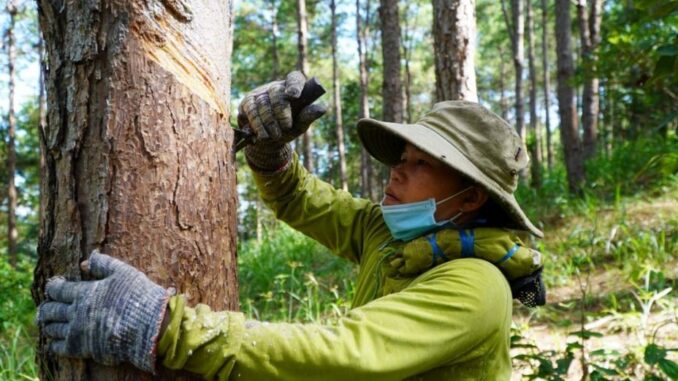
KON TUM – Hundreds of laborers from the northern provinces to the Central Highlands set up shacks and live under the forest canopy to work as a pine tree scraper.

Kon Tum currently has about 8,000 hectares of pine forests, concentrated in the districts of Dak To, Sa Thay, Tu Mo Rong, Dak Glei, Dak Ha…, managed by Southern Paper Material Company Limited.
The company’s partners receive latex exploitation, then assign contracts to employees. They are mainly from Lang Son, Bac Giang, Cao Bang…

When taking plastic, workers must follow a process and technique of exploitation, ensuring the growth and development of pine trees. In 2 years, a tree is only shaved no more than 25 cm long, less than 45% of the trunk wide.
Each pine tree gives resin from 0.5 to 1 kg in a month. But every day the person who goes to pick it up must regularly scrape the bark to let the sap flow.
A plastic bag is placed under the pine tree to collect the plastic. At the end of the month, when the plastic hardens, the collectors will collect these nylon bags and pack them and sell them to the contractor for 10,000 VND per kg.

Dang Thi Lieu, 40 years old, from Lang Son, entered Kon Tum more than 20 years ago. When her marriage broke down, she took her two sons to set up a shack under the forest canopy in Dak Ha District, Tu Mo Rong, working as a pine tree scraper for nearly 10 years. Her 17-year-old daughter returned to her hometown to work as a worker.
For two years now, she has shaved 4,500 pine trees in Dak Tram commune, Dak To district. She and her son (14 years old, dropped out of school from grade 5) earn about 14 million VND per month, except for salted fish sauce, rice, medicine, etc., there is 9 million VND left over.

Holding a latex scraper every day, most of the workers in this profession have calluses on their palms despite wearing gloves. Calluses are large or small depending on how much time you work.

Last school year, before going to work, Ms. Lieu had to take her children to school, about 5 km away. But this summer, his 7-year-old son can only play around the tent alone, with his cat and a homemade wooden stroller.

Due to being in the forest, far from water sources, Ms. Lieu often collects rainwater and stores it in buckets and pots for daily use.
After washing dishes, they are rinsed with clean water transported from nearby houses. Drinking water, cooking rice, washing vegetables… all come from people’s houses. “This year we are fortunate to have a pine forest next to the road and near a clean water source, so it’s more convenient,” said Ms. Lieu, adding that the previous times she was deep in the forest, so she had to use spring water entirely. In nearly 10 years of working, her parents have moved 5 places.

Ms. Lieu had dinner with her youngest child while the second child was taking a bath. Today, she came home late, did not have time to cook rice, and Lieu’s mother and daughter temporarily ate instant noodles and some remaining meat from noon.

More than 500 m from Lieu’s shack, is a “field” tent about 15 m2 wide of Mr. Mai Hong Phuong, 63 years old, from Dinh Lap district, Lang Son province. Mr. Phuong said, the barber only made temporary houses in the forest for convenient transportation. When it rains, the tent often leaks.
In 8 years of working, he has built 3 tents in the forest in Mang Ri, Ngoc Yeu and Tu Mo Rong communes. Two to three years, when the pine tree ran out of sap, he had to move to another forest. Next year, Mr. Phuong plans to go to Chu Pah district, Gia Lai, continue to receive contracts to shave pine latex.

Mr. Phuong alone left his hometown to go to the Central Highlands to make a living. He has not visited his wife and children for two years. “Last Tet because of the epidemic, I could not return to my hometown to visit my relatives,” Phuong said.
This year, he received 3,500 pine trees in Dak Tram commune, earning 6-7 million VND a month. In his spare time, he plays with his dog.

After a month, when the plastic bags were full of turpentine, Mr. Phuong hired 4 more local workers (a labor day of 150,000 VND) to collect in two days.
After collecting turpentine, workers pour it into bags and then use sticks to make the turpentine loosen and sew the bags.

Pine resin is used to process oil and paint for furniture, glue in paper production and a number of applications in the electricity and fuel industry…

Resin gathering point, when enough output, the company will come to buy. Each bag weighs an average of 70 kg.
Follow vnexpress
